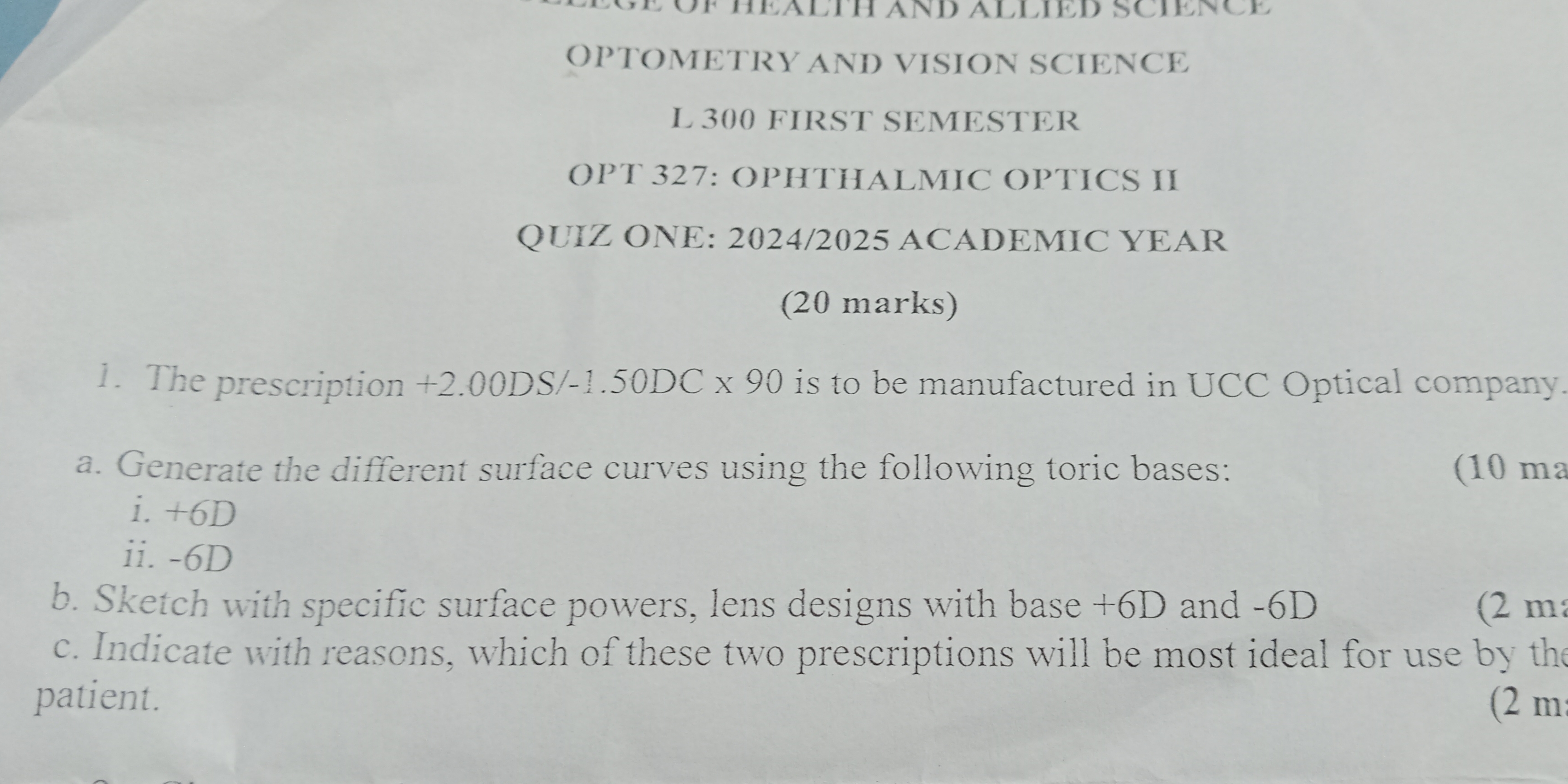The prescription +2.00DS/-1.50DC x 90 is to be manufactured in UCC Optical company. a. Generate the different surface curves using the following toric bases: i. +6D ii. -6D b. Ske... The prescription +2.00DS/-1.50DC x 90 is to be manufactured in UCC Optical company. a. Generate the different surface curves using the following toric bases: i. +6D ii. -6D b. Sketch with specific surface powers, lens designs with base +6D and -6D c. Indicate with reasons, which of these two prescriptions will be most ideal for use by the patient.

Understand the Problem
The question involves ophthalmic optics and requires generating surface curves for a given prescription using different toric bases, sketching lens designs, and indicating the most ideal prescription for a patient with reasons. This requires understanding lens prescriptions, toric surfaces, and lens design principles.
Answer
a. i. +6D base: Front +6.00D, Back $-4.00DS/-1.50DC \times 180$ ii. -6D base: Front -6.00D, Back $+6.50DS/+1.50DC \times 90$ b. Sketches as described. c. +6D base curve is more ideal.
Answer for screen readers
a. i. With +6D base curve: Front surface: +6.00 D (spherical) Back surface: $-4.00DS/-1.50DC \times 180$
ii. With -6D base curve: Front surface: -6.00 D (spherical) Back surface: $+6.50DS/+1.50DC \times 90$
b. Sketches would show the lens cross-sections with labeled surface powers as described above.
c. The +6D base curve is likely more ideal because it will result in a flatter, more cosmetically appealing lens with less magnification for the patient.
Steps to Solve
- Understanding the Prescription
The prescription is given as $+2.00DS/-1.50DC \times 90$. This means:
- Sphere power (DS): +2.00 D
- Cylinder power (DC): -1.50 D
- Axis: 90 degrees
This can also be written in its principal meridians:
- $+2.00 D$ at $90^\circ$
- $+2.00 + (-1.50) = +0.50 D$ at $180^\circ$
- Calculating Surface Curves with +6D Base Curve
For a +6D base curve, we'll place this on the front surface of the lens:
- Front surface powers: +6.00 D in both meridians initially.
To achieve the prescription, the back surface powers must correct the front surface power to arrive at the required prescription powers. Let $F_1$ be front surface power and $F_2$ the back surface power. The lens power $F$ is $F = F_1 + F_2$.
For the meridian at $90^\circ$: $+2.00 = +6.00 + F_{2(90)}$ $F_{2(90)} = 2.00 - 6.00 = -4.00 D$
For the meridian at $180^\circ$: $+0.50 = +6.00 + F_{2(180)}$ $F_{2(180)} = 0.50 - 6.00 = -5.50 D$
Therefore, the back surface is a toric surface with powers -4.00 D and -5.50 D. This can be written as a -4.00D sphere with a -1.50D cylinder i.e. $-4.00DS/-1.50DC \times 180$.
- Calculating Surface Curves with -6D Base Curve
For a -6D base curve, we'll place this on the front surface of the lens:
- Front surface powers: -6.00 D in both meridians initially.
For the meridian at $90^\circ$: $+2.00 = -6.00 + F_{2(90)}$ $F_{2(90)} = 2.00 + 6.00 = +8.00 D$
For the meridian at $180^\circ$: $+0.50 = -6.00 + F_{2(180)}$ $F_{2(180)} = 0.50 + 6.00 = +6.50 D$
Therefore, the back surface is a toric surface with powers +8.00 D and +6.50 D. This can be written as a +6.50D sphere with a +1.50D cylinder i.e. $+6.50DS/+1.50DC \times 90$.
- Sketching Lens Designs
For the +6D base curve:
- Front surface: +6.00 D (spherical)
- Back surface: Toric, with powers -4.00 D and -5.50 D (or $-4.00DS/-1.50DC \times 180$)
For the -6D base curve:
- Front surface: -6.00 D (spherical)
- Back surface: Toric, with powers +8.00 D and +6.50 D (or $+6.50DS/+1.50DC \times 90$)
- Determining the Ideal Prescription
A +6D base curve generally creates a flatter lens, better for plus powers. A -6D base curve will create a steeper more curved lens. For a low plus prescription like this, a +6D will reduce the magnification and be cosmetically more appealing since it keeps the lens flatter to the face.
a. i. With +6D base curve: Front surface: +6.00 D (spherical) Back surface: $-4.00DS/-1.50DC \times 180$
ii. With -6D base curve: Front surface: -6.00 D (spherical) Back surface: $+6.50DS/+1.50DC \times 90$
b. Sketches would show the lens cross-sections with labeled surface powers as described above.
c. The +6D base curve is likely more ideal because it will result in a flatter, more cosmetically appealing lens with less magnification for the patient.
More Information
The choice of base curve can significantly impact the visual and cosmetic outcome of the spectacles for the patient. Flattening the front surface of the lens usually reduces magnification effect.
Tips
A common mistake would be in calculating the back surface powers incorrectly by not accounting for the correct sign conventions or misinterpreting the prescription. Another common mistake would be not properly accounting for the effect of base curve on lens thickness and magnification.
AI-generated content may contain errors. Please verify critical information